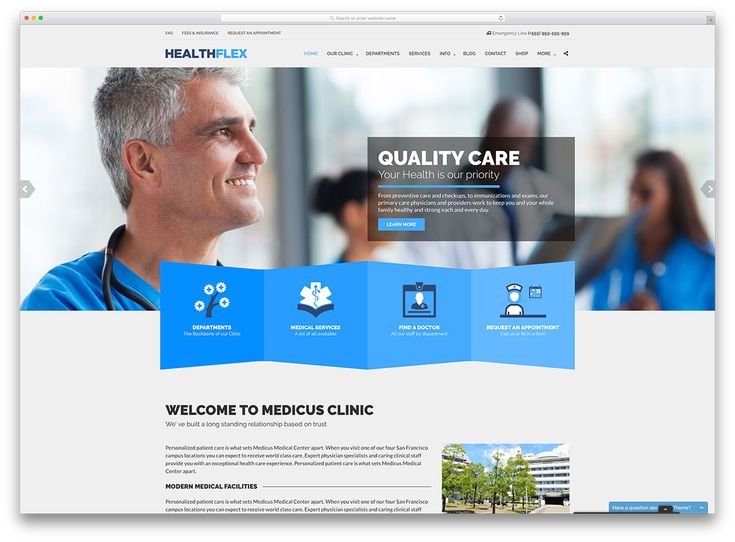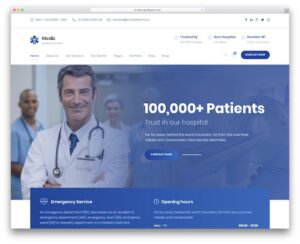In today’s healthcare environment, patients increasingly rely on the Internet to research medical providers, book appointments, and access health information. The first impression of your healthcare organization often comes from its website. A well-designed healthcare website goes beyond aesthetics—it directly impacts patient engagement, trust, and the overall user experience. To attract and retain patients, healthcare providers need to prioritize a healthcare website design that puts patients at the center of the experience, ensuring that it is accessible and easy to use.
In this blog, we’ll explore the best practices for healthcare website design, focusing on creating a patient-centered online experience that promotes trust, accessibility, and engagement.
1. Prioritize User-Centered Design
A primary goal of healthcare website design should be to create a user-centered experience. Patients visiting your website are often looking for specific information, such as contact details, services, or directions to your facility. To ensure a smooth user experience, the website should be designed with patients’ needs and behavior in mind.
Best Practices for User-Centered Design:
- Understand Your Audience: Different types of patients (e.g., first-time visitors, existing patients, caregivers) have different needs. Conduct user research or surveys to understand what information they seek and how they navigate the website.
- Simplify Navigation: Organize your website so users can easily find what they need. Avoid clutter and use well-labeled menus for major categories like “Find a Doctor,” “Book an Appointment,” “Patient Portal,” or “Contact Us.”
- Information Hierarchy: Ensure important information, such as contact numbers, is easily accessible without scrolling. Use clear headings to guide users and structure the content for quick readability.
A user-centered healthcare website design enhances the patient experience by making information easy to find and improving satisfaction.
2. Mobile Optimization is Essential
With most users accessing websites via smartphones and tablets, it’s vital to have a healthcare website design that is mobile-friendly. Google also prioritizes mobile-optimized websites in search rankings, making mobile responsiveness a necessity.
Key Features of Mobile Optimization:
- Responsive Design: A responsive design ensures your website layout adjusts to various screen sizes, providing a seamless experience on both desktop and mobile devices.
- Touch-Friendly Navigation: Make sure buttons, links, and form fields are large enough for easy clicks on touchscreens. Avoid small or hard-to-tap elements.
- Fast Loading Times: Mobile users expect fast loading times. Slow sites can frustrate users. Optimize images, minimize code, and enable caching to improve speed.
A well-optimized mobile experience boosts patient satisfaction and increases the chances of patients staying on your website longer.
3. Ensure Accessibility for All Users
Accessibility is essential in healthcare website design, making sure all users, including those with disabilities, can interact with your site. Healthcare websites should adhere to accessibility standards like the Web Content Accessibility Guidelines (WCAG).
Best Practices for Accessibility:
- Text Alternatives for Non-Text Content: Provide descriptive alt text for images and non-text elements to help visually impaired users who use screen readers.
- Keyboard Navigation: Ensure all interactive elements are accessible via keyboard, not just a mouse.
- High Contrast and Readable Fonts: Use high-contrast color schemes and legible font sizes for users with visual impairments.
- Clear Language: Avoid medical jargon. Use simple language so patients can understand information quickly.
By prioritizing accessibility, you create a more inclusive healthcare website that caters to a wider range of patients.
4. Build Trust with a Professional and Secure Website
For many patients, visiting a healthcare provider’s website serves as their first point of contact. Your healthcare website design should convey professionalism, security, and trustworthiness. A professional website fosters confidence in your practice, while security measures reassure patients that their data is protected.
Best Practices for Building Trust:
- Consistent Branding: Use consistent colors, fonts, and logos that align with your healthcare organization. This reinforces trust and credibility.
- SSL Certificates: Secure your website with an SSL (Secure Sockets Layer) certificate, which encrypts data transmitted between your site and users.
- HIPAA Compliance: For sites collecting personal health information (PHI), ensure compliance with the Health Insurance Portability and Accountability Act (HIPAA). Use secure communication channels and proper data handling practices.
- Doctor and Staff Profiles: Include profiles with professional photos, qualifications, and areas of expertise. This adds a human touch and helps patients connect with providers.
A secure, professional website builds patient confidence, making them more likely to book appointments.
5. Streamline Patient Interaction with User-Friendly Features
To create a truly patient-centered healthcare website design, integrate features that enhance convenience and interaction. Tools such as online appointment scheduling and patient portals improve the patient’s journey.
Key Interactive Features to Include:
- Online Appointment Scheduling: Allow patients to book appointments through a simple, user-friendly interface. This saves time and reduces the need for phone calls.
- Patient Portal Access: Make it easy for patients to log into their secure portals to view test results, communicate with providers, or access their medical history.
- Telehealth Integration: As telemedicine grows in popularity, provide a simple way for patients to schedule and conduct virtual visits.
- Search Functionality: Implement a robust search feature so patients can quickly find providers, services, or health information.
These features enhance patient interaction, improving the overall user experience.
6. Leverage Patient Education and Content
A patient-centered healthcare website design should also serve as a valuable resource for health information. Offering educational content like articles, blog posts, and FAQs improves your site’s SEO performance and provides value to patients.
Best Practices for Educational Content:
- Create Informative Blog Posts: Regularly publish content on health topics relevant to your patients. This improves search engine rankings and engages users.
- FAQs Section: Include a comprehensive Frequently Asked Questions section to answer common queries about services, billing, and conditions.
- Video Content: Create videos explaining procedures, sharing health tips, or featuring patient testimonials. Videos can engage users more effectively and build trust.
Providing educational content positions your healthcare website as a trusted source of information.
7. Optimize for Search Engine Visibility
A healthcare website design is only effective if patients can find it. Search Engine Optimization (SEO) helps improve visibility, driving more traffic to your site.
SEO Best Practices for Healthcare Websites:
- Keyword Research: Identify relevant keywords potential patients are using, such as “pediatrician near me” or “urgent care clinic.”
- On-Page SEO: Optimize each page with relevant keywords, meta descriptions, header tags, and alt text for images.
- Local SEO: Most patients search for healthcare services nearby. Optimize for local SEO by including location-specific keywords and ensuring clinic information is consistent across directories.
- Mobile-Friendly SEO: Since Google prioritizes mobile-friendly websites, make sure your mobile site is optimized for usability and speed.
Effective SEO makes it easier for patients to find your website when searching for healthcare providers.
Conclusion
A successful healthcare website should prioritize patient needs. Focus on user-centered design, mobile optimization, accessibility, and security to attract new patients and improve their experience. Investing in healthcare website design helps practices stay relevant, offering features like online booking and patient education.
Partner with Us for Your Healthcare Website Design Needs
We specialize in custom healthcare website design that meets medical professionals’ unique needs. Whether you need a new site or improvements, we offer solutions to improve patient engagement and support your practice’s growth. Contact us today to transform your healthcare website into a powerful growth tool.




